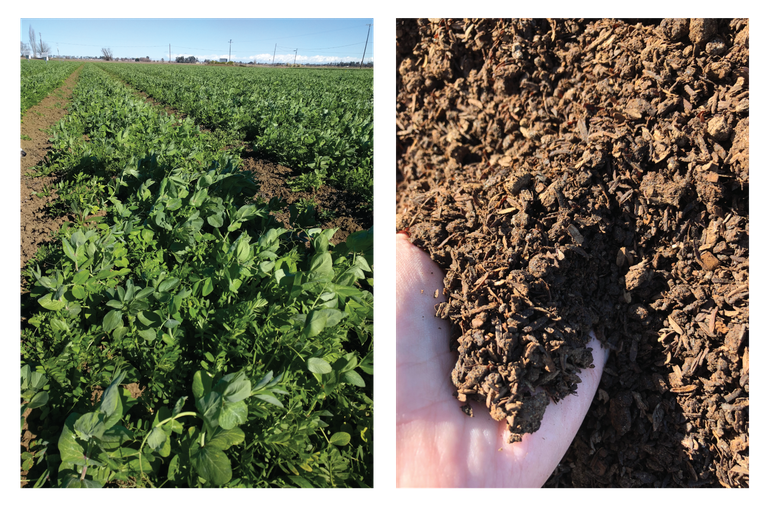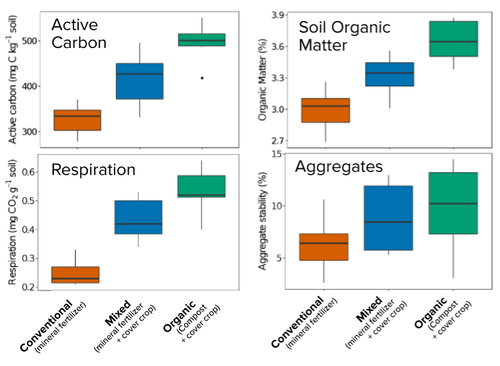We are exploring how different farming techniques impact soil health, and how soil health in turn affects crop productivity and the environmental impact of farming
Soil Health in Context
- Soil that is healthy can sustain its ecosystem of plants, animals, and microbes over long time frames
- Healthy soil provides benefits on the farm, like better water-holding capacity and nutrient cycling, reduced nutrient runoff and soil erosion, and improved crop yields
- Farmers and researchers are exploring how different farm management systems can be used to improve soil health and help ensure the sustainability of California agriculture
How we look at soil health
For over 20 years we have been exploring how different management practices affect soil health. Practices we are investigating include:
-
Winter cover crops: Legume cover crops take nitrogen from the atmosphere and add it to the soil. Cover crops planted in the wintertime when fields may otherwise lay fallow can also help reduce runoff and the associated losses of sediment, nutrients, and pesticides.
-
Applying compost or other organic wastes: Using wastes such as manure, compost, and biochar as alternatives to fossil-fuel-based mineral fertilizers may improve soil health by enhancing the soil’s water-holding capacity.

Key research questions we are exploring at the Ranch include:
- How do soil amendments—like cover crops, biochar, manure, and biodigestate—affect soil chemistry, soil biology, and crop productivity?
- How do organic, conventional, and mixed crop management systems affect soil health?
- How does the long-term use of a soil management practice (over 20+ years) affect soil microbial diversity?
- How does soil microbial diversity, in turn, affect greenhouse gas production and soil structure?
- How does the long-term use of a soil management practice (over 20+ years) affect the amount of atmospheric carbon sequestered in the soil?
Featured Research Projects
- California Tomato Farm Soil Health Survey
- Goal: A survey on 34 fields (11 farms) was conducted throughout the Sacramento and San Joaquin Valleys. The goal of this survey was to identify and characterize soil chemical, physical, and biological parameters on northern and central CA tomato farms, and assess how these parameters impact tomato crop management, health, and yields. Different irrigation and fertility management strategies in processing tomato systems were also evaluated using a Land Use System (LUS) economic model to quantify and evaluate tradeoffs associate with those strategies.
Objectives:
- Identify relationships between soil health properties, irrigation history, agricultural management practices and inputs, and tomato yields/quality.
- Identify relationships between particular management practices (e.g., SSDI management, compost inputs, cover cropping, crop rotation, etc.) and how these impact soil health indicators and soil fertility, ultimately impacting productivity.
- Evaluate impacts of irrigation management and potential strategies to improve soil health (e.g. cover crops, compost) on farm economics by quantifying tradeoffs related to water use, labor inputs, and crop performance.
Read more about the project in the full report.
- Management systems and soil quality
- Manure and winter cover crops are used by organic farmers as sources of nitrogen and other nutrients. Research is exploring how combining these fertilizers with conventional farming methods impacts crop yields, soil chemistry, and soil health.
Explore organic, conventional, and mixed system impacts on inputs and soil chemistry in the interactive graphic.
- Soil health assessment
This section is still under development. See some research results below, and stay tuned for updates.
The use of cover crops increases active carbon, soil organic matter, soil respiration, and aggregate stability, which are all indicators of soil health. Figure adapted from NRCS Soil Health Assessment at Russell Ranch.
Aggregate size fractions in organic furrow- and drip-irrigated systems with poultry manure compost inputs, compared to a conventional drip-irrigated system with synthetic inputs.- Effects of manure compost application on soil health
- Objectives:
Quantifying physical and biological effects of different compost application rates over time on agricultural soil.
Results:
There is a significant increase in soil aggregate stability and water infiltration rates in both levels of application rates.
Compost-derived carbon was identified in soil aggregates of all sizes, but was significantly higher in large aggregates under high application rate.

- Western Alfalfa & Forage Symposium
-
Goal:
Alfalfa was historically an important forage and leguminous perennial rotation crop depended on to rejuvenate soil nitrogen and tilth. However, declining market value and competition from high value crops has contributed to declining alfalfa acreages in the western U.S. While meaningful increases in alfalfa price are not likely on the horizon, a proper valuation of the effects of alfalfa in rotation could incentivize adding alfalfa back into crop rotations for its benefits for soil health, which have been poorly characterized and understudied compared to the nitrogen credit.
Objectives:
To compare a three-year alfalfa crop's effects on soil biological, chemical, and physical soil health indicators
1. at the end of the alfalfa phase
2. compared to an annual corn "control" rotation
3. in the following tomato crop, in the Mediterranean growing climate of northern California.Read more about the project in the full report.
- Effects of irrigation and management practices on soil health and soil salinity in processing tomatoes
-
Goal:
To explore on farm management practices and how these relate to soil health and tomato productivity indicators, including yields. Relationships between soil salinity, mycorrhizal associations, nutrient uptake, and yield will be explored.
Objectives:
(1) Conduct survey of farm management and soil health indicators on processing tomato farms in the San Joaquin Valley.
(2) Determine relationships between saline soils and mycorrhizal associations, and between mycorrhizal colonization and crop nutrient uptake and yield. Determine relationships between soil health indicators and crop nutrient uptake and yield.
Read more about the project in the full report.